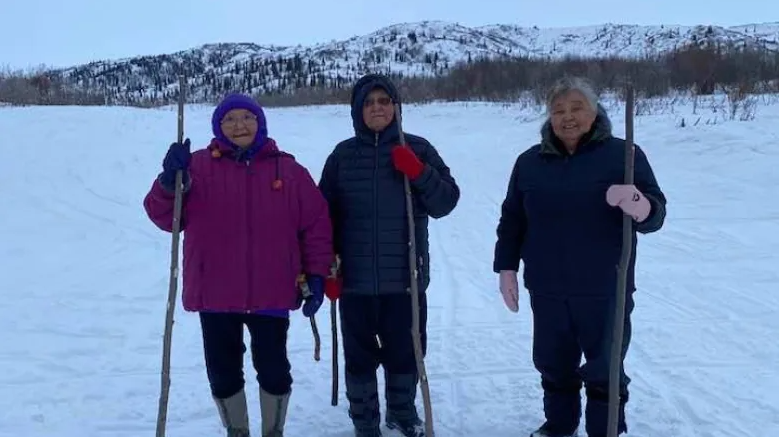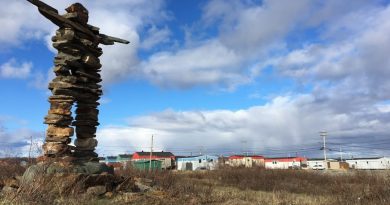N.W.T.’s Indigenous language program starts to pay off in Canadian Arctic

Susan Peffer says she can have conversations in Inuvialuktun as a result of the N.W.T.’s Mentor-Apprentice Program (MAP).
“Every time I talk to both my sisters, it’s always in the language,” she says. “I understand it fluently.”
The program, run through the N.W.T.’s education, culture and employment department, pairs fluent speakers of an Indigenous language with adult learners. Both are paid for practicing the language.
Peffer, who is from Inuvik, participated in the 2020-21 program and was partnered with her mentor — and older sister — Valerie Stefansson.
Together, they’d spend 10 hours a week — often with another pair in the program — working on the language, said Peffer. All four would typically spend five hours together on Saturdays practicing it with a variety of activities.
“We’d make it a fun day,” she said. “We cooked for each other, we ate together, we played a game afterwards, but all using the language.”

As of 2019, the Northwest Territories reported there are 555 speakers of Inuvialuktun. The number has fluctuated: it increased incrementally from 485 in 2004 to 617 in 2014 — before decreasing to 555.
Angela James, the director of Indigenous language revitalization for the education, culture and employment department, said the program has been personally rewarding.
“The most powerful story from the adult learners is [that] many of them deal with shame and inferiority for not being able to know or speak their languages,” she said. “So when they’re a part of [the] MAP, that shame and inferiority dissipates and they feel really good about themselves for learning their languages.”
James said the apprentices are able to pick their mentor, which means it is rare for them to be paired with someone they do not know.
A partnership with Indigenous governments
The program is offered in Inuvialuktun, Gwich’in, Dene Kede (North Slavey), Dene Zhatié (South Slavey), Tłı̨chǫ or Dëne Sųłıné (Chipewyan).
Most of these languages have seen a steady decline in fluent speakers since 2004, according to the territory’s data. Gwich’in has the fewest speakers — there are only 290.
Despite a shrinking number of fluent speakers, James said the program hasn’t had any difficulty finding mentors, largely due to partnerships with the Indigenous governments. The partners include the Inuvialuit Regional Corporation, the Gwich’in Tribal Council, the Akaitcho Dene First Nations, the Sahtu Dene Council, the Tłı̨chǫ Government and the Dehcho First Nations.
Participants are paid for up to 200 hours of learning between August 2021 and March 2022. The territorial government covers the cost of 100 hours, while the six Indigenous governments cover the other 100 hours. The funding was doubled for the current program, and previously covered up to 100 hours.
Mentors are paid a starting rate of $25 an hour while apprentices are paid a starting rate of $20 an hour. Participants must log their language activities to be paid.
The MAP also provides participants with language resources including playing cards, books and recording equipment.

The MAP started as a pilot project in 2019, said James. The education, culture and employment department worked with Leanne Hinton, a University of California Berkeley professor whose research focuses on Indigenous language revitalization. The program also partnered with the University of Victoria and Aurora College.
There were between 35-40 participants in the first official year in 2020, and this year there are 36 participants.
This time around, participants completed an oral proficiency test at the start of the program and will do another test at the end to evaluate their progress.
James credits the program as one of the big initiatives by the department to follow recommendations from the United Nations Declaration on the Rights of Indigenous Peoples.
James said it aims to have apprentices with a desire to continue on their language studies. Applicants must provide a letter of intent, a resume and a letter of support, after which they are interviewed.
This year, she said, the program will conclude with a gathering where each apprentice will deliver a speech in their language they studied.
Related stories from around the North:
Canada: Survey data sheds light on Indigenous languages, traditional activities across Canada’s North, CBC News
Finland: Everyone encouraged to boost Sami language visibility in Finland, Norway and Sweden this week, Eye on the Arctic
Norway: Indigenous and minority language names for Norway now have official status, The Independent Barents Observer
Sweden: Can cross-border cooperation help decolonize Sami-language education, Eye on the Arctic
United States: Inuit leaders applaud UN move to designate International Decade of Indigenous Languages, Eye on the Arctic



